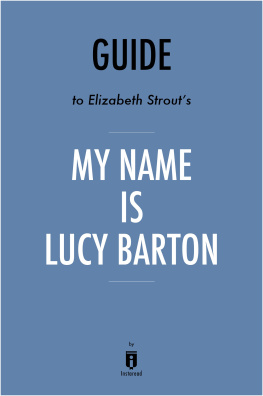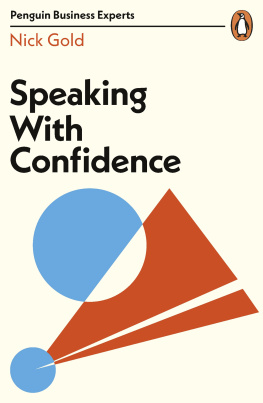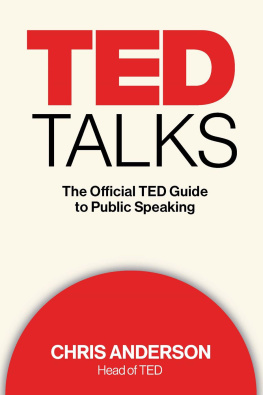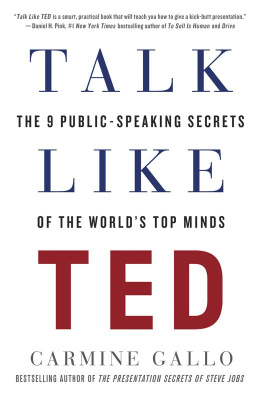Guide to
Chris Andersons
TED Talks
The Official TED Guide to Public Speaking
by
Instaread
Please Note
This is a companion to the original book.
Copyright 2016 by Instaread. All rights reserved worldwide. No part of this publication may be reproduced or transmitted in any form without the prior written consent of the publisher.
Limit of Liability/Disclaimer of Warranty: The publisher and author make no representations or warranties with respect to the accuracy or completeness of these contents and disclaim all warranties such as warranties of fitness for a particular purpose. The author or publisher is not liable for any damages whatsoever. The fact that an individual or organization is referred to in this document as a citation or source of information does not imply that the author or publisher endorses the information that the individual or organization provided. This concise companion is unofficial and is not authorized, approved, licensed, or endorsed by the original books author or publisher.
Table of Contents
Overview
TED Talks is a comprehensive handbook for learning the now-famous TED talk style. TED is a world-renowned conference series founded by Ricky Wurman and Harry Marks in 1984. The book provides tips, tricks, and practical advice to readers who wish to become proficient in delivering effective speeches. The skills described in the book can be applied to a work presentation in a small conference room or a lecture in front of thousands of people.
Even though many Americans fear public speaking, the art of giving a great speech is just another skill that can be learned. There is not a single, set style for delivering a great speech. Speakers must find the style, preparation method, and delivery that works best for them.
While it is important to focus on developing presentation skills, the first objective of all speakers should be to ensure they have an idea that others will find useful or edifying. Simply being able to address a room comfortably, confidently, and engagingly has little value if there is no substance underneath it all. The next objective of the speaker should be to clearly transmit this idea to the audience. There are a variety of strategies that can help make it easier to communicate an idea to a group of people. Sometimes incorporating visual aids will help. Building a narrative can also be a powerful tool for reaching an audience and connecting with them.
The art of public speaking has never been more important than it is now. In the past, the audience of any given speech was limited to whomever was in the room. Today, there are virtually no boundaries on who can access an idea shared in a talk once it is uploaded to the internet. As a result, people who wish to have an impact on the world should carefully practice and hone their public speaking skills.
Important People
Chris Anderson is a British entrepreneur and the curator of TED, an international conference series dedicated to sharing knowledge with a global audience.
Richard Ricky Wurman cofounded TED in 1984 with the intention of making lesser-known information more widely available. His impatience with lengthy lectures and self-promoting speakers helped define the TED style.
Key Insights
- Anyone can learn how to give a great talk.
- Fear can be a positive force in preparation for giving a talk.
- It doesnt matter how well people deliver a talk if they dont have an idea worth spreading.
- There is no single formula for how to deliver a great speech.
- Speakers must find a way to connect with their audience.
- A speaker should consider using a narrative structure as the backbone for a talk.
- Visuals should only be used when they have something to add and do not distract from the speaker.
- Great public speaking skills have never been more important or potentially influential than they are today.
- As computers manage an increasing amount of raw data, the human task of communicating and contextualizing the knowledge gained from automation is becoming increasingly important.
Analysis
Key Insight 1
Anyone can learn how to give a great talk.
Analysis
The ability to give a great talk is called presentation literacy. This used to be called rhetoric, a subject that was once taught in schoolsand still ought to be. Public speaking skills are learned, not innate. The key to presentation literacy is practice. Rehearsal will help speakers sound fluid and natural during their presentation.
Fear of public speaking is very common and can be crippling for some people. Known as glossophobia, anxiety about public speaking may impact 75 percent of the population. [1] Glossophobia is not limited to the fear of giving a speech in front of a large group or in a crowded lecture hall. For some people, it can be just as challenging to speak in front of a small group.
Even billionaire investor Warren Buffett had to overcome a paralyzing fear of public speaking. In college, Buffett deliberately chose courses that did not require class presentations. [2] [3] Later, when he realized his fears potential impact on his career trajectory, Buffett signed up for a public speaking class and addressed the problem head-on. He has since addressed the importance of the skill in his life and its critical role in achieving his astonishing financial success. In a 2013 interview with career website Levo League, Buffett said of his overcoming this fear: You have to learn to communicate in life, its enormously important. If you cant communicate and talk to other people youre giving up your potential. [4] Buffett is well-known proof that fear of public speaking can afflict even those who enjoyed elite education and economic privilege. But he overcame his fear the old-fashioned way: practice.
Key Insight 2
Fear can be a positive force in preparation for giving a talk.
Analysis
Fear can be a very useful tool in public speaking. Adrenaline can prevent a speaker from sounding flat or boring. Although conventional wisdom holds that a speaker should slow down when addressing a crowd, this may deflate the energy in the room and lose the audience. Audiences tend to attach to speakers who acknowledge their vulnerability. Admitting fear or nervousness can help to bring the audience over to the speakers side and cause them to root for the speaker. Ahead of the talk, fear can also be a strong impetus to prepare and rehearse.
Career expert Jane Praeger has reported that fear of public speaking among her clients often had nothing to do with speaking at all. For some people, the real fear was a fear of rejection. For others, it was fear that they might be asked a question to which they didnt know the answer. No matter the cause, understanding that speaking itself was not the trigger of the fear helped to channel nervous anxiety into a positive force. [5]
In a work often cited in the self-help industry, Stanford psychologist Carol Dweck writes about nourishing a growth mindset by encouraging people not to think of their abilities as static but rather as capable of being stretched or changed. [6] People who believe that they are not capable of public speaking can address that fear by realizing that it is a skill they can grow and develop.
Key Insight 3
It doesnt matter how well people deliver a talk if they dont have an idea worth spreading.
Analysis
The most important part of a presentation is to have what TED calls an idea worth spreading. This idea can be intended to change peoples opinions, enhance their lives, or enrich their viewpoints. It doesnt need to be a revolutionary scientific discovery to be worthwhile, but it does need to be a gift to the audience. Good presentation skills alone are nothing without a worthy central concept.
Next page















